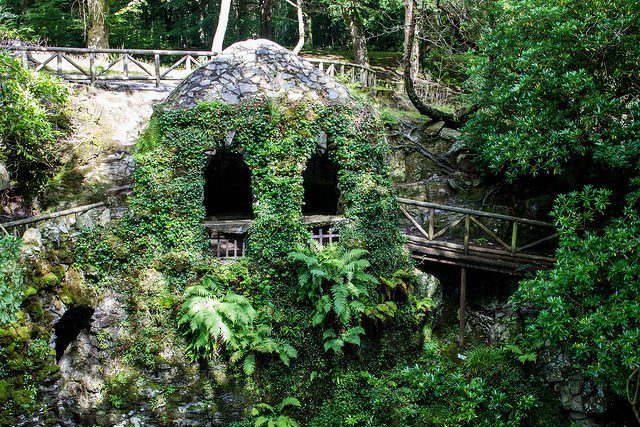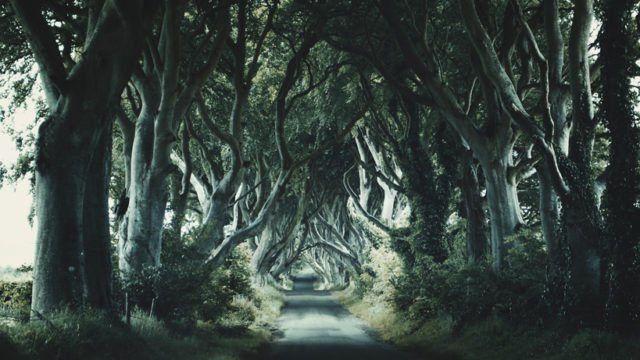George R. R. Martin’s series A Song of Ice and Fire was partly inspired by the Wars of the Roses, a series of 15th-century dynastic civil wars for the throne of England. The novels take place in a fictional world divided into three large continents: Westeros, Essos, and Sothoryos.
Most of the story unfolds over the land of Westeros in a large political entity known as the Seven Kingdoms. However, the world in the series actually includes many other regions not within the political reach of the throne.

The North, the Iron Islands, the Riverlands, the Vale, Westerlands, Stormlands, the Reach, the Crownlands, and Dorne are the nine administrative regions of the Seven Kingdoms. Since the battle for the throne in Westeros is the main focus, the audience only sees the story through the eyes of the medieval population living there.
The author has confirmed that his fantasy world is heavily based on medieval Europe, and most of the continents and inhabitants are loosely comparable to Europe’s cities of the Middle Ages.

Therefore, all the alluring locations seen on-screen in the television adaptation of Martin’s books are dramatic landscapes mostly from around Europe, building the enthralling fantasy world in HBO’s Game of Thrones.
So without further ado, here are some of the most stunning medieval cities, abandoned castles, and a whole other array of locations used in the filming of the series.
England is full of amazing manors and castles – below is drone footage of the Odiham castle – it’s beautiful!
Beyond the Wall (Iceland, Northern Ireland)
Everything beyond “The Wall” that wasn’t filmed in the Titanic Studio in Belfast was shot on the frozen tundra of Iceland. After the end of the first season, in which artificial snow was used, the producers ventured to some of the most desolate lakes and gigantic glaciers on the island for a more realistic effect.

For instance, Mance Rayder’s wildling army can be seen in various shots in Season Three around the shallow, volcanic Lake Mývatn in northern Iceland. Additionally, Grjótagjá, a dazzling cave near the lake that houses a thermal spring, grew to be Jon Snow and Ygritte’s love nest.
The area around Vik, the southernmost village on the island, is used as the frozen wasteland of northern Westeros, and Mýrdalsjökull glacier in the vicinity became the “Fist of the First Men,” the sacred hill for the Night’s Watch.

As for Vatnajökull, Europe’s largest glacier, it is used for a variety of wide shots, so it is no surprise that the producers used its vastness in the show on many occasions. The wall itself and Castle Black are not filmed in Iceland, though, but in Northern Ireland, in Magheramorne Quarry. Iceland featured for the first time in Game of Thrones in Season Two, and ever since the country has seen a sharp rise in tourism.
The North and Winterfell (Scotland, Northern Ireland)
Filming started in Scotland, with the pilot episode shot at Doune Castle in Stirling, which doubled as the home of the King of the North and the house of the Stark family.
The producers of the show struck a deal with the Titanic filming studio in Belfast to film most of their interior scenes there, though, so in order to cut travel costs, they changed their initial plans to shoot here, choosing Northern Ireland and Castle Ward in County Down instead.

This 18th-century stronghold facing Strangford Lough was Winterfell in Season One, and the place where the Starks welcomed King Robert Baratheon. It is also where Bran has his archery lessons and Brienne confronts the Starks. The crew spent eight weeks here building the set of Winterfell prior to the official start of filming, when hundreds of actors and technical crew worked on the set.

Other notable locations throughout Northern Ireland used in the filming of Winterfell and the North are Carncastle in County Antrim and Tollymore Forest Park. This picturesque park situated in Mourne and Slieve Croob Area of Outstanding Natural Beauty, near Newcastle, is where the Starks united with their direwolves.
The Riverlands and the Vale of Arryn (Iceland, N. Ireland)
Although not used in actual filming, the 19th-century German castle of Neuschwanstein, built for King Ludwig II of Bavaria, was used as inspiration for the Eyrie, the magnificent ancient castle, and seat of House Arryn.

As for the Vale of Arryn, one of the regions of the Seven Kingdoms, it’s portrayed mostly through the landscapes of Thingvellir National Park in southwest Iceland, not far from Reykjavík, as well as Glenariff Valley or the “Queen of the Glens” in County Antrim, Northern Ireland.

The central region of the Seven Kingdoms of Westeros, the Riverlands, was mostly filmed in a small area in Northern Ireland. The bay of River Quoile in County Down is where King Robb Stark and his army made the pass so they could open faithful negotiations with Walder Frey.

Additionally, Audley’s Castle by Strangford Lough, also in County Down, provides the scenery for the arrival of Robert Baratheon and his retinue at Winterfell in Season One, as well as the backdrop for Robb Stark’s camp in the next season, where he meets his future wife, Talisa.
The Iron Islands (Northern Ireland)
The small town of Ballintoy and its harbor, near the Giant’s Causeway on the North Antrim coast, was used for the outskirts of Pyke, the capital of the Iron Islands.

Other scenes were shot nearby, at the remote Murlough Bay, which doubled as the Iron Islands, as well as the Crownlands and Slaver’s Bay. This magical spot near the Mull of Kintyre appears three times in the show. Theon Greyjoy is filmed riding with his sister there, as is Davos Seaworth following the Battle of Blackwater Bay. It’s also the background for the scene where Tyrion and Jaime Lannister are captured by slavers.
Slaver’s Bay, Essos (Morocco, Croatia, Spain, N. Ireland)
From the frozen wasteland beyond the Wall and the cold eerie scenery of the North and Westeros, we move to some warmer Mediterranean locations, starting with Slaver’s Bay in the heart of Essos.
As mentioned above, Murlough Bay in Northern Ireland was used in some scenes for this cultural and geographical region of Central Essos, but all of the other locations are spread throughout Morocco, Croatia, and Spain.

The World Heritage Site in Split is an ancient palace built for the Roman Emperor Diocletian in the 3rd century, and it covers about half of the old town. It becomes the city of Meereen in the fourth season of Game of Thrones, as well as the throne room for Daenerys Targaryen.

The exterior appearance of Meereen as we know it is composed of shots of Klis Fortress, a medieval stronghold raised above a village with the same name, near the city of Split, in Croatia. This is the place used for scenes of Daenerys’ wrath and vengeance, which she brought upon the city’s rulers by nailing them on crosses.

Peniscola, often referred to as the “Gibraltar of Valencia,” and locally known as “the City in the Sea,” is a fortified seaport, raised on a rocky cliff about 220 feet high, attached to the mainland by only a narrow strip of land. What the Fortress of Klis previously was in the series, would later (from the sixth season onwards) be substituted with this popular tourist attraction in Spain as the city of Meereen.

Right below Spain, on the shores of Morroco, another UNESCO world heritage site — the town of Essaouira — might be more familiar to viewers as the ancient city of Astapor in the Season Three finale. The Ounila River and the red citadel of Aït Benhaddou was a dream-come-true filming location for the producers of the show, using it as the fictional city of Yunkai.
Dorne (Northern Ireland, Spain)
Apart from the scene in which Jaime Lannister and Bronn face some Dornish soldiers on their way to the Water Gardens, shot at Portstewart Strand in Northern Ireland, Spain provides the beautiful scenery for this southern kingdom.

The actual Water Gardens of Sunspear, the capital of Dorne, are the gardens in the Alcázar of Seville, which is also the location where the exterior of the city itself was shot. The palace is celebrated as one of the most beautiful places in Spain, and as such was used in the visual presentation of a fictional city with similar beauty.

Outside, in the Red Mountains of Dorne, stands the Tower of Joy, which in reality is the Castle of Zafra, built on a sandstone outcrop in the 12th or 13th century to serve as an unconquerable keep. It was intended to mark the border between Christian- and Muslim-ruled territories.
King’s Landing and Braavos (Malta, Croatia, Spain)
We mentioned at the beginning of this article that King’s Landing was initially filmed inside the walled medieval city of Mdina in Malta. It is here where Ned Stark walks through the gates not fully aware of what awaits him, and his daughters are seen running between the corridors and the great halls. In Season One, this fortified city was the home of the Lannisters, the rulers of the Seven Kingdoms.

However, due to the fact that Mdina is miles away from the shore, and the producers needed to film the Battle of Blackwater Bay, they had to move the set elsewhere. With this in mind, from Season Two onwards, the scenes that depict King’s Landing are shot in the Dalmatian city of Dubrovnik in Croatia near the Adriatic Sea.

With its six-meter-thick walls that run almost two kilometers around the city connecting many outposts, towers, and keeps, this is without a doubt the perfect location. Almost everything, from the city walls to the Minčeta Tower—the highest point in the city—was used in the making of Game of Thrones.

For instance, the amphitheater of the abandoned Belvedere Hotel in Dubrovnik is the place where Gregor Clegane (the Mountain) fights Oberyn Martell (Red Viper) for the fate of Tyrion Lannister, resulting in one of the most famous deaths of the series.

The Free City and the Iron Bank of Braavos, the most powerful and wealthiest financial institution in the Game of Thrones world is shot nearby in Kaštel Gomilica as well as in Girona, Catalonia.

Besides these, there are many other locations that inspired some truly unforgettable fictional cities or were used to visually represent something unforgettable described in Martin’s books. The author himself admitted that he took inspiration from Hadrian’s Wall when envisioning the Wall for his series.
This proves that as much as the fictional world in George R. R. Martin’s books is a magical one, it exists in real life, if one knows where to look.
